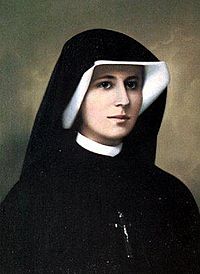Faustyna Kowalska facts for kids
Quick facts for kids Saint Maria Faustina Kowalska |
|
|---|---|

Saint Maria Faustina Kowalska of the Most Blessed Sacrament
|
|
| Confessor | |
| Born | 25 August 1905 Głogowiec, Russian Empire |
| Died | 5 October 1938 Kraków, Poland |
| Venerated in | Roman Catholic Church |
| Beatified | 18 April 1993 |
| Canonized | 30 April 2000 |
| Major shrine | Shrine of Divine Mercy in Łagiewniki, Kraków, Poland |
| Feast | 5 October |
Maria Faustina Kowalska, often called Saint Faustina, was born Helena Kowalska on August 25, 1905, in Głogowiec, which was then part of the Russian Empire. She passed away on October 5, 1938, in Kraków, Poland. She was a Polish nun and a mystic, meaning she had deep spiritual experiences. Today, she is honored as a saint in the Roman Catholic Church.
Contents
Her Life Story
Faustina Kowalska was the third of ten children in a family that was not wealthy. After finishing grade school in 1921, she started working to help her family. Around this time, she felt a strong calling to join the Catholic church as a nun. She believed that God himself was asking her to become a nun.
Helena traveled to Warsaw and tried to join several convents in the city. Each time, she was turned away. Finally, she was accepted by the convent of the Congregation of the Sisters of Our Lady of Mercy. On April 30, 1926, she officially became a nun and was given the name Sister Maria Faustina of the Blessed Sacrament.
Her Special Calling
Saint Faustina said she had special experiences, including visiting a place called Purgatory. She also claimed to have seen and talked with Jesus and Mary many times. Later, she believed Jesus told her that her purpose was to spread the message of God's great kindness, known as the Mercy of God.
On February 22, 1931, Saint Faustina said Jesus appeared to her as the 'King of Divine Mercy'. He wore a white robe, with one hand raised in blessing and the other touching his chest. From his chest came two large rays of light: one red and one pale. Saint Faustina had a painting made of this vision. With help from Father Michał Sopoćko, she shared these images in Kraków and Wilno, and people began to pray before them.
Saint Faustina kept a diary, even though she found writing difficult. This diary was later published as Divine Mercy in My Soul: The Diary of St. Faustina. In her diary, Saint Faustina wrote about her wish to start a new group of nuns. This group would tell the world about God's mercy and pray for it.
Final Years and Legacy
In 1936, Saint Faustina became very ill. Doctors at the time thought she might have tuberculosis. She moved to a special hospital called a sanatorium in Pradnik. She spent a lot of time praying, especially saying the Chaplet of Divine Mercy, and praying for people who had done wrong.
For the last two years of her life, Saint Faustina worked as much as she could. She went between the sanatorium and her sickbed at the convent. By June 1938, she could no longer write in her diary. It was clear she did not have much time left. Saint Faustina died on October 5.
Her spiritual guide, Father Sopoćko, continued to spread the message of Divine Mercy. Saint Faustina was not able to start the religious group she felt Jesus had asked for. However, she had written clear rules for how the group should live. In 1941, the group was finally founded. It is now known as the Institute of Divine Mercy.
Becoming a Saint
The special prayers and message of Divine Mercy became more widely known. Pope Pius XI and Pope Pius XII both supported this devotion. Many important church leaders also believed in The Divine Mercy message.
Faustina was officially recognized as "blessed" (beatified) on April 18, 1993. She was then declared a "saint" (canonized) on April 30, 2000.
Divine Mercy Sunday is a special day celebrated in the Catholic Church. It takes place on the Second Sunday of Easter, which is the first Sunday after Easter Sunday.
Pope John Paul II once said that the message Saint Faustina shared was God's answer for people in our time, which has seen many difficult events.
Saint Faustina's own diary, published by the Vatican, includes direct quotes from her conversations with Jesus. This makes her unique among many people who have reported visions of Jesus and Mary.
Related pages
Images for kids
-
Faustina's chapel at her resting place, the Basilica of Divine Mercy in Kraków, Łagiewniki
See also
 In Spanish: María Faustina Kowalska para niños
In Spanish: María Faustina Kowalska para niños








